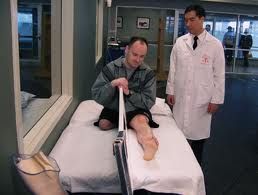Chronic Pain
Clearing the Brain of Phantom Pain
Mirror therapy can re-program a brain's malfunctioning pain system.
Posted May 31, 2012

Mirror therapy in action
I have a vague memory of learning about the brain and pain in the early seventies when I was an undergraduate student. Pain gateways in the brain had something to do with our individual pain thresholds. Since then our understanding of pain has made giant leaps forward, and for the millions of people—about one in six in the population—who suffer from chronic pain, the findings of pain neuroscientists and the development of therapeutic applications based on their discoveries should provide some relief, both emotional and physical.
Justine’s story is not uncommon in the chronic pain world, but her therapy experience is both inspirational and informative. She is a 40-something woman whose left leg was amputated below the knee after a car accident crushed it when she was in her twenties. Although with a prosthesis she learned to walk again, she was plagued by terrible itching and painful cramps in her missing limb for more than 15 years. Her phantom limb took over her life. She was convinced that her marriage didn’t survive because of her obsession with finding out why she had these debilitating cramps when others in the same situation did not. She decided her marriage breakup was for the best, as children were definitely out for her; she could never look after them while suffering this much agony, or alternatively being drugged to the eyeballs with pain medication. For years she managed to hold down a job as an office assistant, but only because she had a sympathetic boss who overlooked her frequent days off. But when she was 38, she resigned, no longer able to pretend that she could cope. After a year of social isolation and depression, she read an article in the local paper about a pain clinic that performed wonders for victims of chronic pain. She didn’t believe it could help her, but by now she would give anything a try. If she didn’t, she feared that her belief that suicide was a sin would forsake her. “Those therapists in the pain clinic literally saved my life,” she told me.
After very thorough physical, psychological and medical assessments, Justine was given her schedule. Five days a week she attended the clinic, moving through three types of therapy: cognitive behavior therapy, graded motor imagery, and mirror therapy. She began with cognitive behavior therapy where she unpacked her beliefs—the main one simply I can’t bear these painful cramps any longer—and learned how to re-program her thoughts, and in time her beliefs, to more positive and constructive ones. My cramps are bearable; I can get rid of this pain because it is in my brain, not in my missing leg; I can re-program my brain.
The psychologist also helped her understand how the brain fooled her into thinking her crushed leg was still there. Pain, she explained, results from damaging tissue and nerves, but you experience it via your brain. If you’re unconscious you can’t feel pain, however badly your body is burned or crushed. When you suffer an injury—for example, if you burn your hand on the iron—the pain sensors in your hand fire signals up your spinal cord and alert your brain. If this didn’t happen you might not pull your hand off the iron and rush to the sink to run cold water over your hand. But the brain doesn’t respond simply on autopilot. It constructs how you feel your pain based on your past experiences and beliefs, and even your genetics, as well as on the actual physical pain sensation from your hand. If you expect your hand to still be on fire after 10 minutes of cold water, it likely will be; your brain will keep the pain volume turned up. If you have been burnt before and know it will sting for a while but is no big deal, your brain will turn down the pain. It’s a sort of placebo effect, little different from when a mother tells her child that she will kiss the grazed knee better, and the child’s tears dry instantly and she runs happily back to play.
When pain continues after the body is healed, or as in Justine’s case, when the painful body part no longer exists, it is a sign that the brain’s central pain system has gone into overdrive. It hasn’t realized that a warning that your body is damaged or sick, and needs to be protected so it can heal, is no longer needed. This may be the culprit in a myriad of conditions when the pain is out of proportion to the physical problem or disease. Irritable bowel syndrome, chronic back pain, fibromyalgia, stress headaches, mild arthritis which should entitle the person to mild pain only… the list goes on. The owners of these pain-filled lives are not making it up, exaggerating, or being wimps. They really are in pain, but its ferocity comes largely from their mind, not their body.
It has been shown that some of our characteristic behaviors, even our personality, can play a role in priming our brain for pain. If you are an anxious sort of person, if you tend to look at everything as a catastrophe waiting to happen and obsess over everything that could go wrong, if you are depressed or are a pessimist, this can change the way your brain processes physical damage to your body, amplifying the pain signals.
Justine listened intently to all this, and it made a lot of sense for a grazed knee or a superficial burn, or even as an explanation for chronic pain from a bad back, but what about painful cramps in a leg that wasn’t even there?
Vilayanur Ramachandran’s fascinating research on phantom limbs has been the basis for much of our knowledge in this area. How can we feel a limb that we can see isn’t there; how can we scratch away that interminable itch, or dull that shooting pain in an absent leg with a drug designed to work on the physical body? When a limb is amputated, it is thought that the nerve cells in the somatosensory area of the cortex of the brain undergo substantial reorganization, sometimes resulting in mixed signals and fooling the brain into thinking the limb is still there. Before her leg was amputated Justine had suffered severe and appropriate physically-generated pain, and as a result, her brain assigned more nerve cells to the crushed leg, in order to protect it, using pain to warn Justine to treat her leg with care. Don’t knock it! This process where the brain map changes to assign more nerve cells to a damaged body part has been termed “smudging”, and essentially means that the body part gets bigger in the brain. The brain’s representation of a phantom limb becomes smudged, generating not only the sensation of the limb, but pain from the limb, even though the limb is no longer present.
Ramachandran came up with the idea of mirror therapy for phantom limb pain in the 1990s. Later, in 2009, Australian neuroscientists, Lorimer Moseley and Peter Brugger, incorporated it into graded motor imagery. Justine’s cramping pain in her phantom leg was so invasive that she no longer wanted to walk on her prosthesis, because this sometimes resulted in agonizing cramps in her missing foot and calf and into her stump. So the physical therapist began the next stage of her therapy by teaching her to imagine moving her left leg. First, all she had to do was watch a woman on a television screen walking and imagine it was her. We know that there are neurons in the brain that fire both when we imagine ourselves moving a specific body part and when we actually move that part. It is like rehearsing without the risk. Some athletes swear by it; they first visualize themselves performing perfectly—a perfect run down that ski slope, a perfect long jump, a faultless throw of the javelin—and then when they do the real action their brain is primed for the right moves, allowing the athlete to relax effortlessly into the right motions. (That’s the theory, anyway. I can tell you from my own experience on the ski slopes that it doesn’t work so well for amateurs!)
When Justine visualized herself as the woman walking on the television, it wasn’t painful. By doing this over and over, day after day, she re-programmed the neurons in her brain; almost as if the brain finally got the message that walking on her prosthesis and thus walking on her own phantom limb might not be painful either. After a lot of intensive imagery work, Justine began to walk again without the constant fear of painful cramps. But she still suffered cramps in her leg at times, often when she first got up in the morning, or when she was tired. Time to move onto mirror therapy.
The therapist sat her down with a long mirror placed between her bare legs, and facing towards her right side, the stump of her left leg hidden behind the mirror. Now she looked whole again. She ran her hand over her right leg and massaged her foot. In the mirror her left hand did the same to her left leg, and although she knew it was a reflection the sensation was spooky; it was as if her left leg had come back and felt normal, just like her right leg. The itch she had constantly in her left leg was relieved when she scratched her right leg, and when she smoothed soothing cream on her right leg, it soothed away the itch in her left leg as well. She began to experiment at home, whenever the cramps began, and found that by sitting with the mirror fooling her brain into thinking she had a left leg, she could turn off the cramps. The relief was so startling that it became part of her morning routine: a session with the mirror as soon as she got out of bed.
Six months later her phantom cramps had disappeared, and she no longer needed the mirror therapy. Along with the pain went the irritating itching, and without that she no longer felt her lower leg. What a relief that was. She loved that stump! She was soon weaned off the cocktail of pain relievers and antidepressants she’d been taking. Now all she had to contend with was the discomfort she sometimes felt from the pressure of the prosthesis on her stump, but that was normal, and a minor irritation after the years of agony she had suffered. Her brain map had been un-smudged, and her brain’s pain control center was back on track, telling her when her prosthesis was too tight, but no longer needing to tell her to protect that missing leg.
Mirror therapy is by no means a cure for everyone with phantom pain, and there is still controversy about its effectiveness. Even Moseley, the originator of the therapy, now has serious doubts about its effectiveness (http://cdns.bodyinmind.org/wp-content/uploads/Moseley-et-al-2008-PAIN-t….) New theories are emerging to explain phantom limbs, and as always in science, they will continue to be updated as neuroscience research techniques improve.
But for Justine, mirror therapy along with other therapies, a positive attitude, and a great deal of hard work proved effective. For more on this fascinating topic, read the latest case study published this year by McGeoch and Ramachandran, another case of the banishment of phantom pain using mirror therapy. (McGeoch, P., and Ramachandran, V., (2012), The appearance of new phantom fingers post-amputation in a phocomelus, Neurocase, 18 (2), 95-97.)




